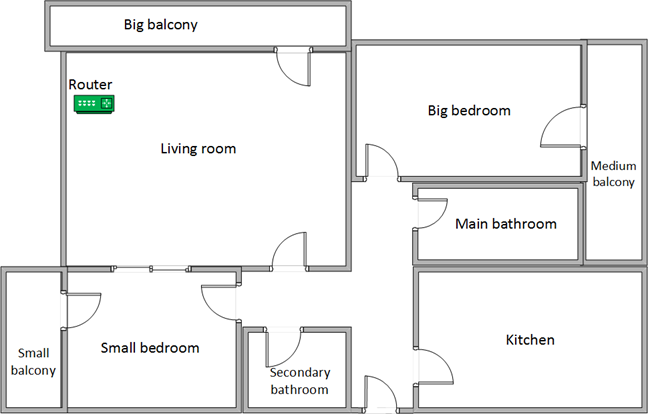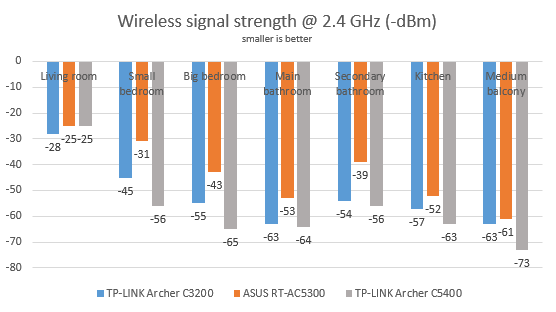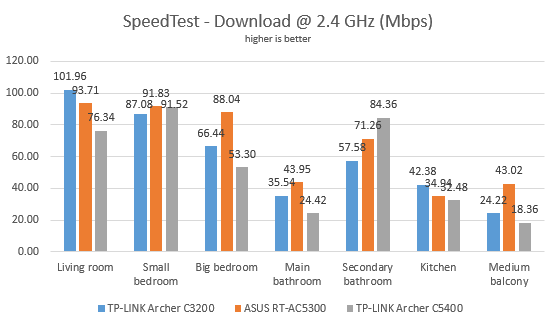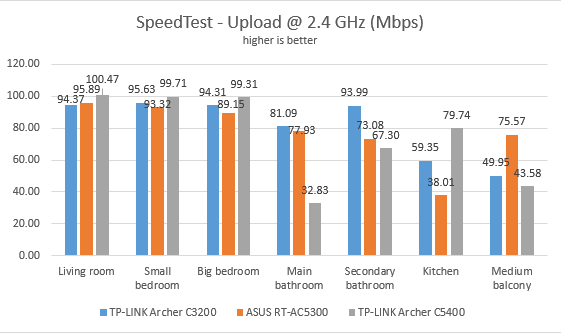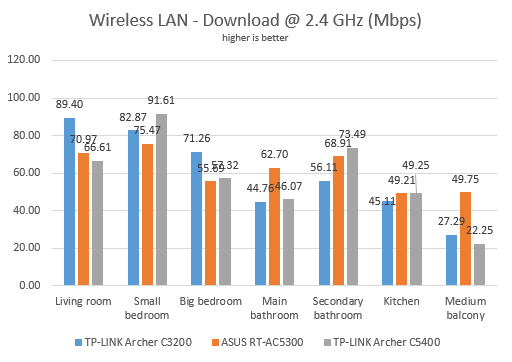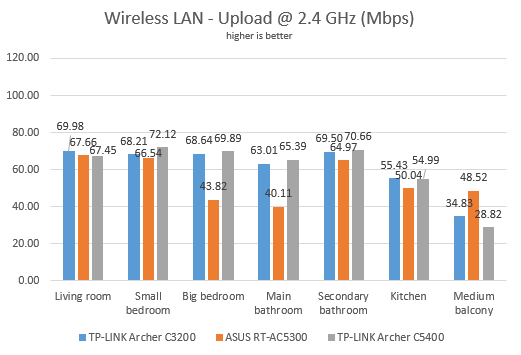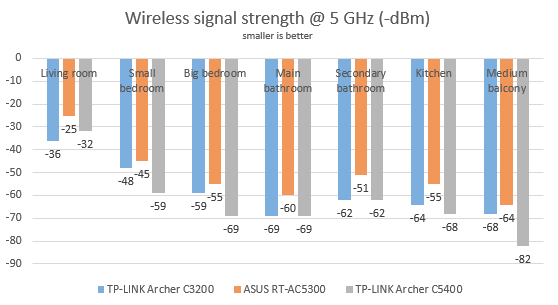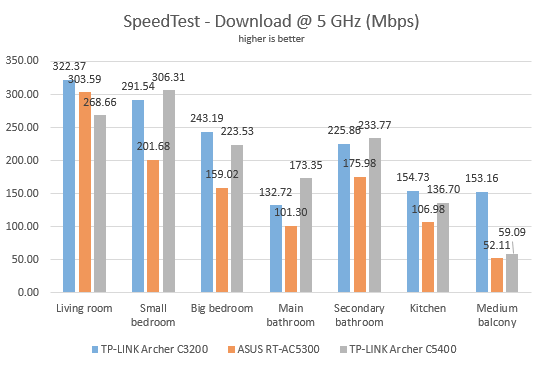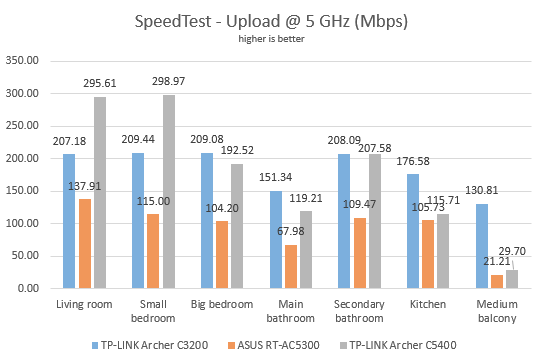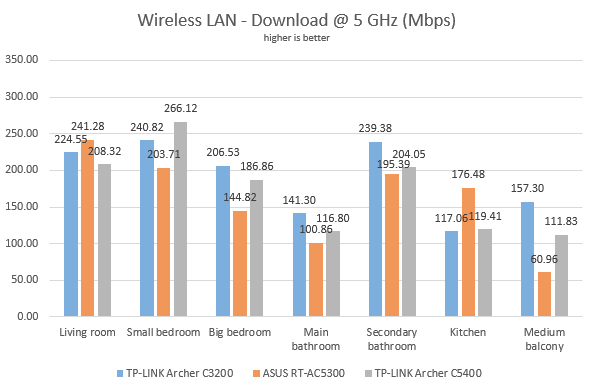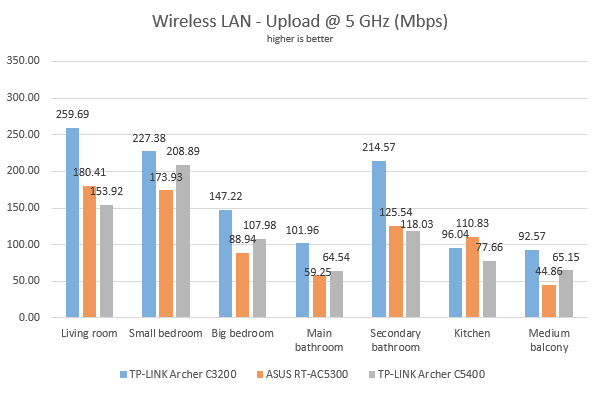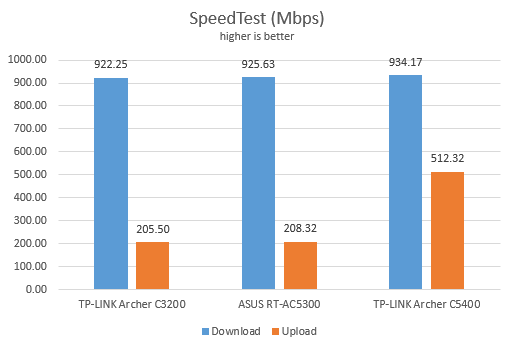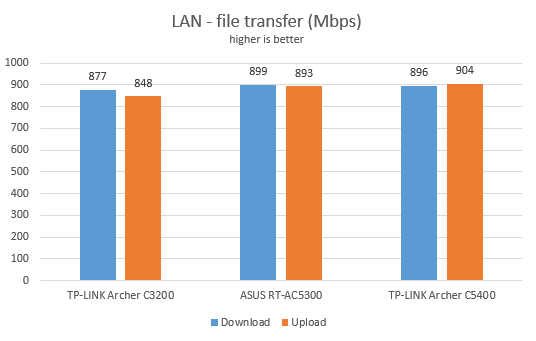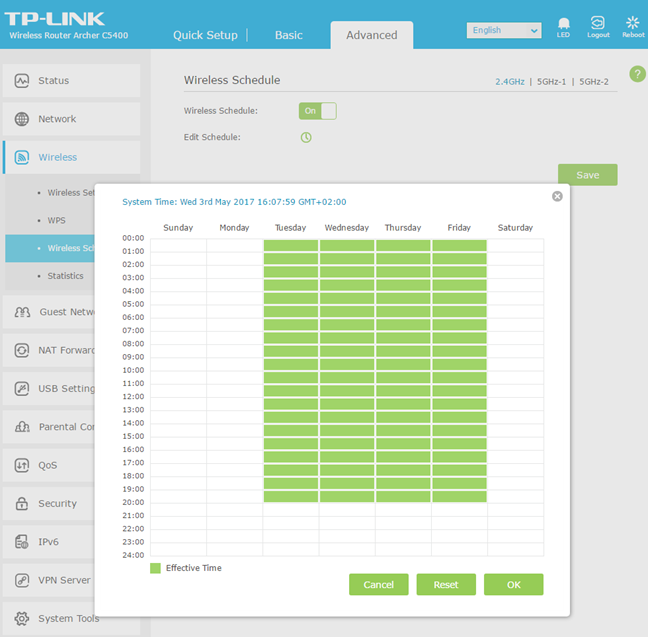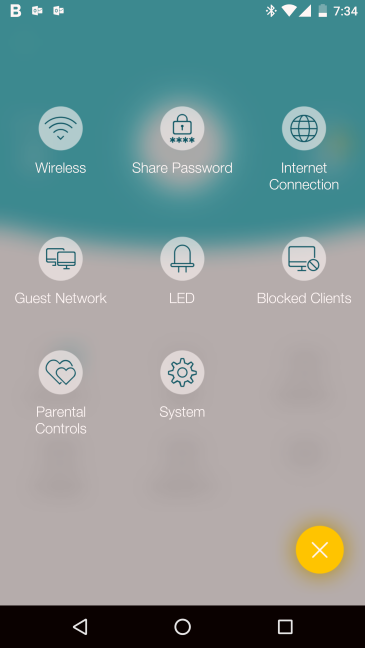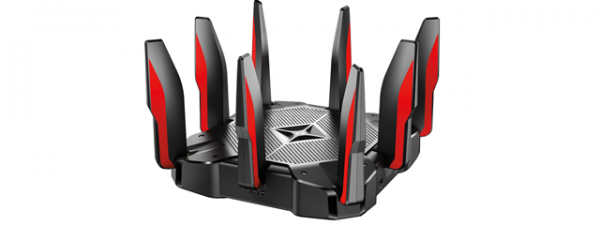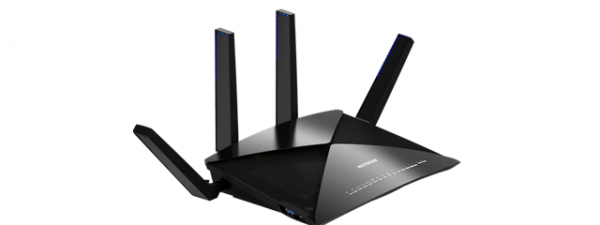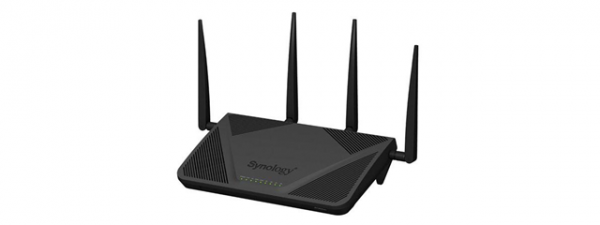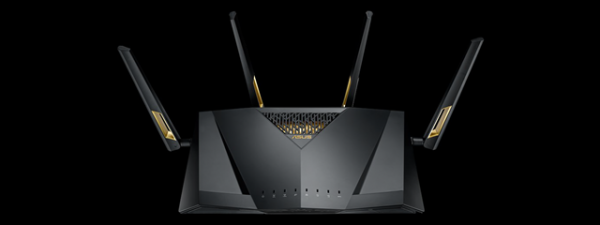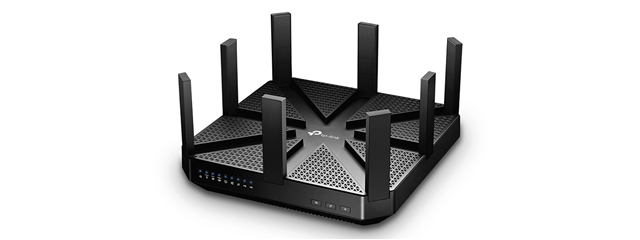
Wireless network performance
Before sharing our measurements, let's take a look at the apartment that was used in our testing and how it is set up. You can see that the router is placed in the living room. With most wireless routers, the signal strength is not that high in rooms like the Kitchen and the Medium balcony.
Our testing was done using a fast 1 Gigabit Internet connection that's capable of uploads on the internet of up to 500 Mbps. We used a Microsoft Surface Pro 3 for all our measurements and several software tools. To get a better perspective of the performance offered by TP-LINK Archer C5400 we compared it with ASUS RT-AC5300 and TP-LINK Archer C3200.
We first evaluated the performance of the wireless network that is broadcast on the 2.4 GHz wireless frequency.
We ran an app called inSSIDer and measured the strength of the wireless signal in all the rooms of our apartment. Below you can see that TP-LINK Archer C5400 offered good signal strength, but it was outperformed by ASUS RT-AC5300 in all rooms.
The signal strength doesn't tell us how fast a wireless network connection is. Therefore, we first used SpeedTest to measure how fast is the internet connection in all rooms. Again, TP-LINK Archer C5400 delivered good performance when measuring the download speed but it was outperformed by its competitors.
We were surprised to see how fast the uploads were on the 2.4 GHz wireless frequency broadcast by TP-LINK Archer C5400.
For the next set of measurements, we used LAN Speed Test Lite to measure downloads and uploads when transferring a 350MB file between two computers connected to the network. In the download test, TP-LINK Archer C5400 was fast but outperformed by its competitors in all rooms.
Again, things improved a lot when measuring the upload speed over the 2.4 GHz wireless network.
The 2.4 GHz wireless frequency that is broadcast by the TP-LINK Archer C5400 is fast but not the fastest you can get. Competing routers, including more affordable ones, like Archer C3200 tend to outperform it.
Next, we evaluated the 5 GHz wireless frequency. We started by measuring the signal strength in each room. Again, TP-LINK Archer C5400 offered good signal strength, but it was outperformed by ASUS RT-AC5300 in all rooms.
We ran SpeedTest to see how fast the internet connection is on this wireless router. TP-LINK Archer C5400 delivered great results, but it was outperformed by its more affordable brother, Archer C3200, who was faster, especially in the rooms that are furthest from the router.
When measuring the upload speed, TP-LINK Archer C5400 delivered outstanding results, beating its competition in all rooms except one.
Next, we measured downloads and uploads when transferring a 350MB file between two computers connected to the network. In the download test, TP-LINK Archer C5400 delivered great results, but it was outperformed by its more affordable brother, Archer C3200.
The same story was true when evaluating the upload speed.
Our conclusion is that TP-LINK Archer C5400 is a very fast wireless router but, to take advantage of all its advanced wireless networking features, you need premium computers and devices with support for the latest networking technologies. Otherwise, more affordable routers, like the TP-LINK Archer C3200 tend to outperform it.
Wired network performance
To test the quality of the wired Ethernet connection, we used a desktop PC, equipped with an Intel Core i5 4460 processor, running at 3.20GHz, 16GB of RAM and a very fast Samsung 850 Pro 512GB SSD and a Microsoft Surface Pro 3 with an Intel Core i5-4300U processor, running at 1.9 GHz, 8 GB of RAM and a fast 256 GB SSD drive from Samsung.
We started by measuring the download and upload speeds using SpeedTest. As you can see below, TP-LINK Archer C5400 managed to deliver impressive speeds, much faster than its competitors.
In the graphic above you see that TP-LINK Archer C3200 and ASUS RT-AC5300 reached uploads of only 200 Mbps. That's because, at the time we tested these models, our internet connection was capped at 200 Mbps for the upload speed. Since then, our ISP has raised the cap to 500 Mbps.
Then, we transferred an 883 MB file between the same two computers connected to the network, both of which were using an Ethernet cable. Again, TP-LINK Archer C5400 was an outstanding performer.
Our tests have shown that TP-LINK Archer C5400 is very capable of delivering Ethernet connections at 1 Gbps.
Extra features
TP-LINK Archer C5400 offers the following additional features:
- Wireless schedule - you can set a weekly or daily schedule for the broadcasting of the wireless signal.
- Guest network - you can enable up to three guest networks, one for each band. Visitors should not be allowed to access your network, for increased security and privacy.
- Smart Connect - this service balances the load and assigns devices to the most appropriate band so that it reduces delays and interruptions.
- QoS - a basic Quality of Service feature that helps you control how the total bandwidth is split between devices and applications. Unfortunately, this service cannot run while the NAT Boost feature is enabled. You have to disable NAT Boost before being able to control the bandwidth in your network. Unfortunately, TP-LINK doesn't explain in its documentation what the NAT Boost is, how it works and why it is enabled by default.
- USB applications - which allow you to connect USB storage devices like an external hard disk or a printer and share them with the network.
- Parental Controls - this module allows you to control the internet access of devices on your network as well as block access to certain websites based on keywords. It's a rather basic parental controls feature which has limited usefulness.
- Dynamic DNS - allows you to assign a fixed host and domain name to a dynamic IP address. It can work with the No-IP and DynDNS service providers.
- VPN server - you can set the router to work as a VPN server using OpenVPN and PPTP VPN protocols. The router also allows VPN pass-through for clients that are connecting to external VPN services.
- IPv6 - support for IPv6 addresses and internet connections.
- System Tools - a collection of logs, statistics and diagnostic tools that allow you to troubleshoot problems.
- TP-LINK Tether App – an Android and iOS app that allows you to manage the router from your smartphone. The app is very basic, and it doesn't help with administering more advanced features. You have to use your computer and a web browser for advanced administration tasks.
While TP-LINK AC5400 offers some useful extra features, the number of tools offered and their usefulness is slightly fewer than what you get from competing wireless routers from other manufacturers. The feature that we like best is the possibility of setting your router to work as a VPN server so that you can access your network while traveling.
Pros and cons
TP-LINK Archer C5400 has many pros to consider:
- It's future-proof regarding support for the latest networking technologies
- It has very powerful hardware that is capable of delivering stable and fast wireless network connections
- It offers true 1 Gbps Ethernet connections
- Its firmware offers excellent multi-lingual support, which is a welcome change for TP-LINK wireless routers
- It is easy to setup and use
- You can mount it on walls
However, there are some downsides to consider:
- To take advantage of its advanced features, you need new and expensive computers and devices with support for the latest networking technologies, meaning that the total investment in your network will be very high
- For current networking hardware, more affordable routers, like TP-LINK Archer C3200 deliver better performance
- Competing AC5300 or AC5400 routers offer even more advanced features in their firmware

Verdict
Wireless routers with a total maximum bandwidth of 5300 Mbps or more have one problem: they are too advanced for their time. With existing computers, smartphones, tablets, consoles and printers, you don't have the chance to experience the ultimate speed that they are capable of. TP-LINK Archer C5400 is no exception to this "rule." This router is fast, is powerful, with many advanced features and excellent multi-lingual support. However, modern-day computers and devices don't offer good support for the newest wireless technologies that are included TP-LINK Archer C5400. Therefore, more affordable models, like TP-LINK Archer C3200 tend to deliver better performance because they are "less advanced." A router this feature-packed is an investment for the future and the future of wireless networks. If you can afford it, go ahead and buy it. You won't regret the purchase.


 10.05.2017
10.05.2017 